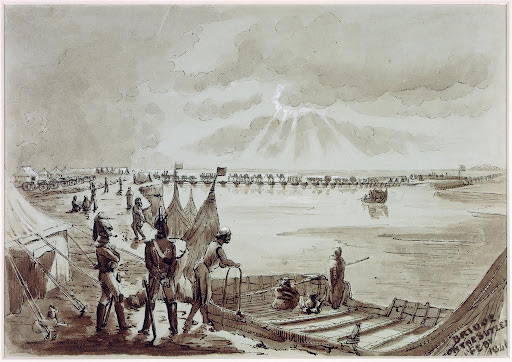Adelaide Magnolia Letter 23 - European Trade

Bridge on the Sutlej. Sir Henry Yule 1846. Courtesy of the British Library

Flag of Dutch East India Company

Flag of British East India Company
The Dutch East India Company, also known as the United East India Company, or the VOC, was founded in 1602, and was a pioneering force in the spice trade originating from the Netherlands. With the primary aim of monopolizing trade in the East Indies (present-day Indonesia), the VOC armed itself with a formidable fleet, and being backed by the Dutch government, established trading posts, controlled key ports, and secured lucrative partnerships with local rulers. Its success stemmed from a combination of strategic alliances, naval supremacy, and efficient commerce, focusing on spices like nutmeg, cloves, and pepper.
The VOC's influence extended beyond trade; it possessed its own army, waged wars, and governed territories, effectively operating as a quasi-state. However, its dominance faced challenges due to conflicts with other European powers and the burden of managing vast territories. Despite initial prosperity, internal corruption, mismanagement, and economic decline eventually led to its dissolution in the late 18th century.
The British East India Company, or the EIC, established in 1600, emerged as a force in trade and colonization, marking its presence primarily in the Indian subcontinent. Initially focused on the lucrative textile trade, the EIC expanded its influence by establishing forts, acquiring territories, and exploiting local resources. It gradually gained control over key regions in India, leveraging its military might and political maneuvering.
The EIC's impact was not merely economic; it significantly influenced India's socio-political landscape. The company indirectly ruled vast territories, transforming from a trading entity to a territorial power. However, its rule was marked by exploitation, economic plundering, and social upheavals, leading to the Indian Rebellion of 1857, which ultimately resulted in the British Crown assuming direct control of India.
The EIC and the VOC were direct competitors of each other. The competition was especially fierce amongst the spice trade in the Moluccas; Islands in Indonesia where, at the time, only certain spices could be found, such as nutmeg and cloves. Tensions ran so high between the companies that four separate wars broke out during the mid 1600s to late 1700s.
Both companies shared similarities in the way they operated, including autocratic practices, colonization efforts, and wielding considerable political power. Both, in addition to trading goods, were also involved in the slave trade. Transporting abducted adults and children from Africa to their occupied territories and forcing them into labor for the company. In addition, these individuals were treated as commodities and were traded just as spices and silks were.
The legacy that both these large corporations left are monumental. For both Britain and the Netherlands their companies vastly opened up international trade routes, brought goods into their countries that enriched their society, and improved their national economy. Conversely, these companies were very imperialistic in their attempts to monopolize their trades and in doing so engaged in excessive violence, wars, destruction, etc. all leading to tens of millions of deaths. Most of the deaths were due to famine in both regions because of the immense impact that these European forces had on local agriculture.
As the first examples of multinational corporations, the EIC and VOC were the world’s first look at “big business” and the quest for excessive gains and wealth on a large scale. Many of the lessons learned today in economics on open markets, monopolies, and corporate accountability can be traced back to these two companies.
Sources:
https://en.wikipedia.org/wiki/East_India_Company
https://en.wikipedia.org/wiki/Dutch_East_India_Company#Criticism
https://geheugen.delpher.nl/en/
https://theecologist.org/2006/nov/01/east-india-company-first-multinational-corporation
https://www.government.nl/topics/discrimination/history-of-slavery/the-history-of-slavery-in-the-kingdom-of-the-netherlands
